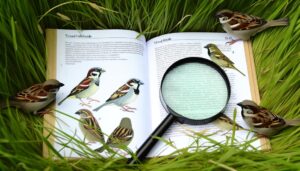Identifying How Chipping Sparrows Are Related to Buntings
Yes, Chipping Sparrows are genetically related to Buntings. Despite falling under different taxonomic families, both species share a strong evolutionary linkage, showcased by comparative genetic studies and strikingly similar physical traits.
They also exhibit communal social structures and diet preferences, further strengthening their connection. From identical chromosomal arrangements to common habitat tendencies, the interconnectedness between Chipping Sparrows and Buntings offers valuable insights into avian evolution and biodiversity.
Expanding upon these findings will provide more compelling evidence of their unique shared lineage.

Key Takeaways
- Chipping Sparrows and Buntings belong to different families, Emberizidae and Passerellidae, respectively, in bird taxonomy.
- Despite different classification, genetic studies reveal a close relationship between these bird species due to significant gene overlap.
- Both species share common characteristics such as small to medium size, seed-eating habits, complex vocal abilities, and communal social structures.
- Sparrows and Buntings have similar dietary and habitat preferences, often resulting in geographical overlap and potential for hybridization.
- Similar chromosomal arrangements in these species suggest a common ancestry, providing insights into avian evolution and speciation.
Understanding Bird Taxonomy
To understand the intricate relationship between the Chipping Sparrow and Buntings, one must explore the rich complexities of bird taxonomy. The classification of birds, known as avian taxonomy, is a scientific method that organizes birds into hierarchical categories based on their evolutionary relationships, physical characteristics, and genetic similarities. It's a meticulous process involving the careful examination of morphological features, DNA analysis, and often, behavioral studies.
Buntings are part of the Emberizidae family, a group known for their seed-eating habits and distinct bills. On the other hand, Chipping Sparrows belong to the same family but are classified under the genus Spizella. Therefore, despite some shared characteristics, they're not identical, highlighting taxonomy's role in understanding their nuanced relationship.
Overview of Chipping Sparrows
Sporting a crisp gray breast, a sturdy bill, and a distinctive rust-colored cap, the Chipping Sparrow is a small songbird that's known for its cheerful trill and distinctive appearance.
Belonging to the Spizella genus within the Passerellidae family, this bird is widely distributed across North America. In the scientific community, it's identified by its binomial name, Spizella passerina.
The Chipping Sparrow primarily feeds on seeds, with insects becoming main dietary components during breeding season. Its habitat ranges from open woodlands to urban gardens.
The bird's moniker, 'Chipping', refers to its sharp, repetitive call that resonates in its environment. Regarding physical characteristics, the Chipping Sparrow exhibits sexual monomorphism, meaning both sexes share similar plumage.
Distinct Characteristics of Buntings
While Chipping Sparrows captivate with their distinctive trill and rust-colored caps, Buntings, on the other hand, boast vibrant colors and distinctive markings that set them apart in the avian world.
Male Buntings, in particular, are known for their strikingly colored plumage, often in bright blues, reds or yellows, which they use to attract mates during the breeding season.
Females, however, possess more muted hues, a common phenomenon in the bird kingdom known as sexual dimorphism.
Buntings also exhibit a unique behavior called 'anting', wherein they apply ants, or sometimes other insects, to their feathers. Scientists believe this might help them ward off parasites.
These traits, along with their distinct, melodious songs, make Buntings a fascinating subject of study for ornithologists.
Sparrows and Buntings: Shared Features
Despite their distinct traits, Sparrows and Buntings share some common features that make them both remarkable in the world of ornithology. Both species are small to medium-sized birds, with strong, conical beaks adapted for seed-eating. Their plumage tends to be dull, often in shades of brown or grey, aiding in their camouflage within their natural habitats.
Both Sparrows and Buntings exhibit sexual dimorphism, where males are more brightly colored than females, a feature linked to mating displays and competition. They're also both known for their vocal abilities, possessing a range of complex and melodious calls.
These shared characteristics hint at a common ancestry and indicate similar evolutionary pressures, although they've adapted differently over time.
Genetic Connections: Sparrows and Buntings
Delving into the genetic connections, it's evident that Sparrows and Buntings are more closely related than one might initially assume, with recent genetic studies shedding light on their shared ancestry. This relationship is particularly apparent in their DNA – the complex molecular structures that dictate the traits of every living organism.
Comparative analysis of their genetic sequences reveals a significant degree of overlap, suggesting a common evolutionary path. Scientists have pinpointed specific genes that both species share, further confirming their genetic link. Additionally, studies on mitochondrial DNA, inherited exclusively from the mother, have also yielded similar results.
Therefore, it's clear that these birds aren't just similar in appearance, but genetically intertwined too. This connection provides a fascinating insight into avian evolution and speciation.
Studying Sparrow and Bunting Habitats
Beyond their genetic connection, the Sparrows and Buntings also share striking similarities in their habitats, offering another layer of insight into their close relationship. Both species prefer open or semi-open areas, often residing in grasslands, forests, and suburban areas.
| Species | Preferred Habitat |
|---|---|
| Sparrows | Grasslands |
| Buntings | Forests |
| Sparrows | Suburban Areas |
| Buntings | Open Fields |
These habitats provide ample food resources and nesting sites, influencing their distribution patterns. However, Buntings tend to prefer more open fields compared to Sparrows, indicating a slight divergence in their habitat preferences. This in-depth study of their habitats not only deepens our understanding of their relationship but also highlights the importance of habitat preservation for these species' survival.
Analysis of Diet and Behaviour
Studying the dietary needs and behaviours of both Chipping Sparrows and Buntings provides valuable insights into their ecological roles and interrelationships.
Importantly, an in-depth analysis of the Chipping Sparrow's feeding habits and the Bunting's dietary preferences is essential in understanding their survival strategies in different habitats.
A comparative study of their behavioural patterns further illuminates the subtleties of their social interactions and mating rituals, which can contribute to the broader knowledge of avian behavior.
Chipping Sparrow's Feeding Habits
The Chipping Sparrow, a close relative of the bunting, exhibits fascinating feeding habits. Primarily subsisting on a diet rich in seeds and insects, they show a marked preference for beetles and caterpillars during the breeding season. Through careful observation, it's apparent that these birds demonstrate a specific feeding pattern.
- Chipping Sparrows forage mainly on the ground, but also glean from low vegetation.
- Their insectivorous diet increases in the breeding season, aiding in protein intake for egg production.
- Outside the breeding season, they rely heavily on seeds, including those of grasses and weeds.
- They've been observed to occasionally feed on fruits and berries, supplementing their diet.
This analysis of the Chipping Sparrow's feeding habits portrays a bird that adjusts its diet based on season and available resources, revealing an adaptive and flexible survival strategy.
Bunting's Dietary Preferences
Shifting our focus to buntings, we find that their dietary preferences, much like the Chipping Sparrow's, adapt according to seasonal changes and available resources. Buntings primarily feed on seeds, but during the nesting season, their diet expands to include insects, providing necessary protein for their growing offspring.
This dietary shift demonstrates an impressive level of adaptability and resourcefulness in the face of environmental changes. Scientific studies have also observed buntings consuming small fruits and berries, further diversifying their diet.
Their beak shape, sharp and pointed, is perfectly adapted for their seed-based diet, yet versatile enough to handle insects and fruits. This adaptability in diet speaks to the buntings' resilience and survival instincts, traits that are essential in the ever-changing natural world.
Behavioural Patterns Comparison
When comparing the dietary habits and behaviours of buntings and Chipping Sparrows, one can't help but notice striking similarities, indicating a shared evolutionary lineage and environmental adaptability.
- Both species primarily feed on seeds and insects, exhibiting an omnivorous diet.
- Buntings and Chipping Sparrows share similar foraging patterns, often scouring the ground or low vegetation for food.
- Their social structures display communal tendencies, with both species exhibiting flocking behaviour outside of the breeding season.
- The nesting habits of both birds also align, preferring to nest in shrubs or low trees.
These parallels in dietary and behavioural patterns not only suggest a common ancestor but also highlight how both species have successfully adapted to their environment. This comparative analysis provides compelling evidence of a genetic link between buntings and Chipping Sparrows.
The Intriguing World of Bird Genetics
In order to fully comprehend the relationship between Chipping Sparrows and Buntings, a thorough understanding of bird genetics is necessary.
A comparative analysis of the genetic makeup of Sparrows and Buntings can provide insights into their evolutionary connection and shared characteristics.
Additionally, exploring the phenomenon of hybridization in bird species can shed light on the adaptability and survival strategies of these avian species.
Understanding Bird DNA
Genetic analysis has revealed a fascinating link between the DNA of Chipping Sparrows and Buntings, shedding light on the intricate world of bird genetics. Bird DNA, like that of all creatures, is a complex and intricate system that has evolved over millions of years.
Understanding bird DNA involves examining the genetic makeup of various species, including the sequences of nucleotides that make up their genes.
In the domain of bird genetics, several key factors are at play:
- The role of genetic mutation in species diversification
- The impact of geographical barriers on gene flow
- The influence of natural selection on genetic traits
- The genetic similarities and differences between species
Each of these factors contributes to the rich diversity we see in bird species today, offering a fascinating glimpse into the world of avian evolution.
Sparrows Vs Buntings Genetics
Delving into the intriguing world of bird genetics, we find that Chipping Sparrows and Buntings share surprisingly similar genetic markers, a discovery that's transforming our understanding of avian evolution. Recent studies reveal that these species, despite noticeable differences in plumage and habitat, possess nearly identical chromosomal arrangements. This genetic correlation suggests a close evolutionary relationship, possibly indicating a common ancestor.
Through the lens of molecular phylogenetics, evidence indicates that Sparrows and Buntings diverged from each other only recently in geological timescales. Scientists have attributed this late divergence to environmental factors and selective pressures. However, the exact cause remains elusive.
This genetic similarity challenges traditional taxonomic classifications, prompting the need for more thorough genomic analysis. A clear understanding of their genetic makeup will provide more insight into their evolutionary history.
Hybridization in Bird Species
While the genetic similarity between Sparrows and Buntings presents an intriguing case, another fascinating aspect of avian genetics is the phenomenon of hybridization among bird species.
Hybridization, the interbreeding of two distinct species, is a process that can result in offspring with a mixture of traits from both parents.
Key factors influencing hybridization include:
- Geographical overlap: Species living in close proximity are more likely to interbreed.
- Similar mating calls and rituals: Birds with similar courtship behaviors may attract each other.
- Absence of strong genetic barriers: Some species have fewer genetic incompatibilities, enabling easier hybridization.
- Environmental changes: Shifts in habitats can force different species into closer contact, promoting hybridization.
This complex process further enriches the intricate tapestry of avian genetics.
Conclusion
In the grand tapestry of avian genetics, Chipping Sparrows and Buntings represent intriguingly interconnected threads. Despite physical differences, shared traits and habitats hint at a common ancestry.
Their dietary choices and behaviors further underscore this kinship. However, the full extent of their genetic link remains shrouded in mystery, akin to a cryptic bird song.
As we explore further, these winged enigmas continue to illuminate the complex, fascinating world of bird taxonomy, compelling us to investigate more.





